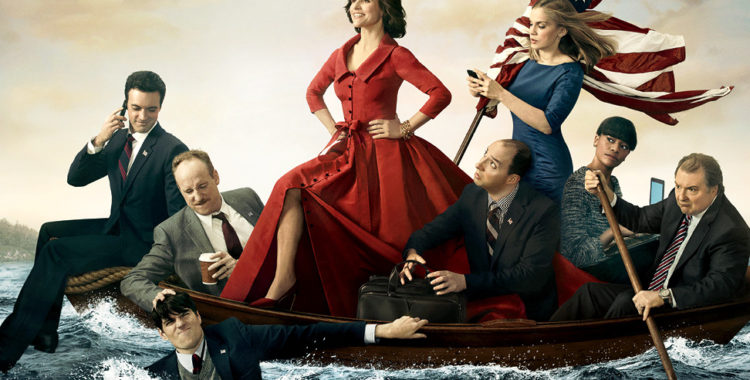
As Seen on TV: Thoughts on Art Exposure Through Television
October 22, 2017
by Diana Greenwald | Filed in: Interdisciplinary
Binge-watching is a wonderful thing. Netflix, Hulu, and other streaming services can provide hours of entertainment in one sitting. Recently, waiting for the new seasons of my favorite shows to start, I began watching ABC’s Designated Survivor. The series begins with the far-fetched concept that almost all of the U.S. Government is wiped out by a terrorist attack during the State of the Union. The well-meaning Housing and Urban Development Secretary (played by Kiefer Sutherland) was the “designated survivor” kept away from the Capitol for the event. He suddenly becomes president and chaos ensues.
As the series progresses from an action-packed hunt for terrorists who blew up the Capitol Building to a more West Wing-style political series, I started noticing something: the art in the background of political conversations. From a shrunken version of Emanuel Leutze’s Washington Crossing the Delaware (1851) to Childe Hassam’s The Avenue in the Rain (1917). Colonial, nineteenth and twentieth-century American art is constantly on display on this TV Show. Having noticed this background artwork in one series, I suddenly started noticing the artwork in the background of all the (many) shows I watch. The artistic environment in Designated Survivor closely resembles that of other political shows, like Madam Secretary, House of Cards and Veep (whose play on Leutze’s image of Washington is the feature image for this post.) Beyond politics, the background in series like Mad Men or Girls or Louie.
The number of viewers who can see original works of art has always been limited. Because of geographic distance or private collections, original pieces are often inaccessible to most members of the public. In earlier centuries, prints and other reproductions of artworks corrected for this problem. Though not access to the original, prints provided approximations of paintings and exposed audiences to a wide range of visual culture.
The twenty-first-century version of print culture is decidedly digital. One can quickly locate photographs of famous works on Wikipedia and Google Image searches. However, television—both experienced on a traditional television set and a computer—has also become an important channel for communicating information about art. Unlike a Google Image search where someone looks for a specific work of art, on TV artwork is used to set a scene. Art on TV is curated, and often it is curated to communicate an atmosphere: to project power and dignity in politics, to make the Mad Men appear avant-garde or, in the case of Crazy Ex-Girlfriend, to poke fun at one’s character’s love of wolf imagery.
According to the Alliance of American Art Museums, there are 850 million museum visits per year in the United States. This is a big number and growing number. Assuming that the average museum visit lasts two hours (and assuming that the majority of U.S. museum visits are by Americans rather than foreign tourists) we can estimate that Americans spend 1.7 billion hours in museums per year. While this is a lot of time spent in museums (many of which are ar museums), it pales in comparison to the time Americans spend on TV. Including estimates for time spent on streaming services, Americans watch about five hours of TV per day on average. Multiplying this number by 365 days a year and 323 million Americans, you end up with almost 590 billion hours of TV watched per year. This 347 times more hours spent watching TV than in a museum. This means that many Americans may be exposed to art primarily through their favorite television shows.
How does this made-for-tv curation form their understanding an appreciation of art? Does it transform the reputation of some works and, therefore, demand for them? Nineteenth-century American painting is consistently displayed in the White House and other traditional places of political power, while Abstract Expressionism and contemporary art make an appearance in the offices and lives of New York’s creative classes, both during the ‘60s and the present-day. The decision to place particular artworks in particular settings is, of course, based on real-life observation. There is, in fact, a Childe Hassam painting in the Oval Office and young Brooklynites—like those who inspire the characters in Girls—probably do interact more with contemporary art than historical pieces. Nonetheless, the reinforcement of these associations in the mass media likely has an effect on how certain kinds of art are perceived—to what extent some pieces are traditional or “cool.” Typically, art historians think of museums and galleries as the primary sites of shaping narratives about art and visual culture. Television is also widespread and important vehicle for exposing people to a specially curated sample of works.
The Power of Art to Sell, a Conference Response (Part 1) >>
<< Empathy, New Media, and an Inclusive Economy
